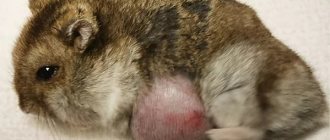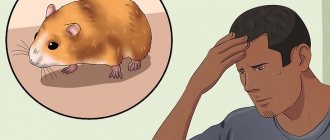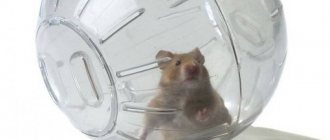- home
- General information
28.03.2018
The foot of a domestic hamster is no more than a couple of centimeters, the size of the bones in it is even smaller. Therefore, limb injuries in hamsters are common. Sometimes the animal does not even realize the presence of injury and continues to lead an active lifestyle, injuring itself even more. How to recognize that your pet needs help? How to treat a fracture in a hamster? What to do if you can’t see a veterinarian? Let's look at it in order.
How can you tell if your paw is broken?
Even animals that do not leave their cage often suffer bruises, sprains and dislocations. Often these types of injuries go unnoticed because the animal in pain reduces physical activity and hides in its house until the discomfort passes. The fracture can be open or closed:
Closed fracture
- the limb hangs unnaturally;
- the animal moves on three limbs, pressing the injured paw to the body;
- the injured paw is swollen and there is noticeable bleeding;
- the hamster tries to move as little as possible and refuses food.
IMPORTANT: You should not palpate a rodent's paw to diagnose a fracture, since the hamster's bones are too thin for a fracture to be detected by palpation. This will aggravate the injury and cause unnecessary suffering to the animal.
If possible, it is recommended to take an X-ray to make a final diagnosis. A closed fracture is often confused with a dislocation. A modern digital device is capable of detecting fractures in even the smallest animals.
Open fracture
With an open fracture, the picture is clearer; it is impossible not to notice it. Added to the above signs is the most obvious one:
- the skin is damaged and a piece of bone is sticking out.
With a closed fracture, the bones can heal on their own
Consequences of a fall
Shock
If a pet that has just fallen off the table rushes like a bullet under the sofa or to another secluded place, the animal is very frightened. Stress is dangerous for hamsters, so you will have to wait a while before catching your pet.
The owner wants to quickly inspect the “parachutist” and make sure that he is okay. But if you start picking out the fugitive with a mop, frightening it and grabbing it with your hands, the consequences of such care will be more dangerous for the animal than the injury itself.
The extreme degree of nervous shock is shock. In this state, the fallen hamster seems to be stunned: it lies on its back or on its side without moving for up to 5 minutes. Having woken up, the animal intensively digs the litter and hides. A Djungarian or Campbell's hamster can die due to stress alone.
Help: put the animal in a cage, keep it warm and do not disturb it for a while.
Fractures
In a state of shock, a pet can actively move even on broken limbs. Therefore, it is necessary to draw conclusions about the consequences of the injury the day after the fall.
If one of the hamster's legs is broken, it swells, may be red or blue, and is twisted unnaturally. With a closed fracture, the rodent simply moves unnaturally and limps. When open, the wound and bone damage are visible.
If the spine is fractured, the hind legs will be paralyzed. If, in addition to the ridge, internal organs are damaged, the animal will die. When only the spine is broken, the animal will survive if the functions of urination and defecation are preserved. Pelvic limb paralysis is most often irreversible, but a disabled hamster will be able to lead an active life.
Damage to internal organs
If, after a dzhungarik has fallen, he bleeds from his nostrils, the owner thinks that the hamster simply broke his nose. However, if the hamster fell from a great height, and blood comes not only from the nose, but also from the mouth, this is a pulmonary contusion. Foaming from the nose and mouth is a sign of pulmonary edema. In both cases, the pet cannot be helped.
If a hamster falls from a height, it can damage any internal organs, which the doctor or owner can only guess about. Bleeding due to a ruptured liver leads to the death of the animal. When the bladder ruptures, the animal does not pee, and the stomach increases until the pet dies.
The Syrian hamster is the largest of the decorative ones, weighing 120-200 g, but even with them diagnosis is difficult (ultrasound, x-ray), and with dwarf hamsters it is almost impossible.
Incisor fracture
If a hamster hits its face, it can break its long front incisors. The problem itself is not fatal, but can lead to more serious problems if the bite is not corrected. After a tooth fracture, the paired incisor does not grind down and grows excessively: its length is adjusted by trimming it with a regular claw cutter. Until the incisors are restored (about a month), it is difficult for the hamster to eat solid food and requires a special diet.
Caring for an injured hamster
An injured animal must be provided with quality care and medical attention as early as possible. Treatment should be carried out depending on the complexity of the fracture, sometimes even amputation of the limb is necessary. In no case should you leave a hamster without treatment: with an open fracture, suppuration, gangrene and death of the animal are inevitable.
With a closed fracture, the bones can heal on their own, but if they heal incorrectly, they will cause lifelong lameness in the hamster.
Limited mobility
First of all, even before consulting a veterinarian, you need to limit your pet’s mobility as much as possible. To do this, place it in a bowl or container where a drinking bowl and feeder will fit, but there will be little room for movement.
Place plain paper on the bottom - hamsters don’t like to stir it up. Have you already taken your hamster to the vet?
How to feed a hamster with a fracture?
The most important rule for feeding an injured animal is moderation and lack of experimentation with food. It is better to reduce the amount of food a little. It is especially important not to allow your hamster to stuff food into its cheeks if its front leg is broken, as the animal may injure it further in the process.
It is best to give a grain mixture in a small bowl, green leaves and vegetables. Insect larvae, cottage cheese and kefir can be given in microscopic doses, provided that they were included in the hamster’s diet before.
There is a chance of getting purulent inflammation
Useful video
Often you may not notice your pet's injury immediately, but after several days, when the hamster's paw changes color and the hamster limps.
But it is important to provide the right help as soon as you notice the animal’s suspicious behavior.
Hamsters are small, very active animals that love to run and play. Unfortunately, the active lifestyle of a furry pet often leads to injuries. Additionally, if you have multiple hamsters that don't get along very well, they may fight and cause some pretty serious injuries to each other. If you notice that your pet has been injured, you need to act quickly: provide the pet with the necessary assistance and help it quickly return to a normal, active life.
Open fracture
An open fracture requires especially careful maintenance of the cleanliness of the cage and careful wound care. The risk of getting purulent inflammation and losing the animal is very high.
The situation is complicated by the fact that hamsters are not wearing collars, which limit the ability to lick the wound, and their saliva contains a huge number of dangerous microbes. In addition, parts of food, bedding and feces will inevitably get into the wound.
Caring for a Hamster with an Open Fracture
In case of an open fracture, the wound should certainly be treated with an antiseptic at least twice, and ideally four times a day.
Treatment is carried out with a solution of chlorhexidine, miramistin or furatsilin. Rinse generously, under pressure - a syringe without a needle works well. A warm solution will cause less suffering to the animal, so it is better to store it at room temperature and warm it slightly before use.
Keeping the cage clean
Cleaning a cage with a sick animal should be done very often, at least once, and preferably twice a day. Completely replace the bedding (use plain paper instead of sawdust), change the water in the drinking bowl, immediately after feeding, remove the remaining food from the feeder so that the hamster does not stock up.
A sick animal needs to change its diet
Symptoms
A paw fracture is an injury to the bones of the fore or hind limb. Depending on the injury received, the following types of fracture are distinguished:
- Open. Characterized by damage to the skin and protrusion of the bone.
- Closed. With such a fracture, the integrity of the skin is not damaged, but the bone is partially or completely broken.
Symptoms of a fracture:
- Strong pain. When you feel the sore paw, the animal may behave aggressively, try to get out of your hands or bite. In this way he reacts to the pain in a broken limb.
- Bend the paw. In order not to touch the sore paw, the rodent bends it under itself.
- Unnatural mobility. A tarsus fracture may be characterized by a dangling limb.
- With an open fracture, the bone is visible.
- Swelling or hematoma may form near the site of injury.
- The hamster may refuse to eat.
A bending does not always mean that the hamster has broken its leg. Perhaps it's just a dislocation. The condition is painful, but less dangerous than a fracture. How to distinguish a dislocation from a fracture? When a limb is dislocated, the animal may partially rely on the injured paw and limp. The same symptoms accompany a bruised paw.
What NOT to do for fractures in a hamster
There are things that absolutely cannot be done if a hamster is diagnosed with a fracture:
- Give calcium tablets or increase the proportion of cottage cheese and kefir in the animal’s daily diet. New products cannot be introduced. Excess calcium will inevitably lead to kidney problems, and a new product in the diet will provoke an upset stomach, from which the hamster is much more likely to die than from a fracture.
- You cannot put a cast on the paw, as instinct will force the hamster to chew it to get rid of the “trap”, and the paw will be even more injured.
- Set the bone, apply bandages and splints. It is impossible to set a bone in an animal on your own; it will bring nothing but torment and aggravation of the consequences of the injury. An infection will quickly develop under the bandage and, at best, the animal will lose its paw. A splint cannot be applied, since the risk of crushing the paw is very high, and this will cause necrosis of the entire limb, and amputation will become inevitable.
- Apply Levomekol and similar ointments to a fresh wound (they should be used only in case of purulent inflammation).
- Use powders that promote the formation of a crust on the wound, for example, Baneocin and Streptocide. An infection will quickly develop under the crust and the animal will die.
Be sure to contact your veterinarian
Veterinary assistance
It is best to show the animal to a specialized specialist immediately after discovering a fracture. It is best to visit a doctor who specializes in rodents - a ratologist.
The veterinarian may prescribe pain medication for 1-3 days. If you managed to get to the doctor a few days after the injury and the wound has already festered, you may need injections of an antibiotic: Baytril, Enroxil or regular human bicillin-3 diluted with water for injection.
If a doctor recommends amputation of a limb, the owner had better agree. It will be performed under general anesthesia, and the stump will heal quite quickly. The animal’s quality of life will not suffer too much; they are quite well adapted to move on three or even two legs.
Limb injuries heal quickly
Treatment
Showing your hamster to a specialist is vital for your pet. A rodentologist or ratologist, using a special apparatus, will be able to determine the nature of the fracture. An open injury can be seen by punctured skin or a piece of bone sticking out. A closed fracture can be complex, such as the bone being cracked in several places. Modern X-ray machines make it possible to take pictures even of such miniature animals as a hamster. This means that the doctor will be able to prescribe high-quality treatment that is adequate to the type of injury. After all, if the bones heal incorrectly, the baby will remain lame.
In difficult cases, the doctor may prescribe an anesthetic drug. If the fracture is of an open type, an antibiotic injection (Bicillin, Baytril) will be given as an option to exclude infection. In some cases, the veterinarian insists on amputating the paw. There is no point in arguing with him; the animal will manage without one limb. The operation to remove the diseased limb is performed under anesthesia, and the animal is not in any danger.
Important! In the wild, rodents themselves chew off the paw in such situations, and in the case of gangrene, the hamster can die.
Rehabilitation after a fracture
Complete recovery of a paw after a fracture can take 2 to 4 weeks. During this period, mobility restrictions are still relevant. If for some reason the animal needs to be returned to the cage, all ladders, running wheels and other toys should be removed from it. Change the litter regularly.
IMPORTANT: under no circumstances should an injured animal be released from the cage to avoid falling from a table, sofa, etc. You should not pick it up so as not to aggravate the injury.
After consulting a doctor and providing first aid, the pet should be closely monitored. After the first three days, you can judge the success of the therapy. If the paw begins to dry out or turn black, you need to urgently consult a doctor - amputation is required. However, sometimes animals simply gnaw off an injured limb; this instinct is inherent in them by nature.
Causes of falls and sources of danger
There are many factors that contribute to pet falls.
It is important to find out the cause of what happened in order to prevent this from happening in the future. From a breeder who ignores the reason? pet injuries are quite common
A small rodent may fall from a height if:
- the cage is incorrectly selected for the size of the animal, there are many dangers in it (ladders, swings, high labyrinths);
- the bars of the cage are too wide, or the door is not closed, and the pet has the opportunity to escape from it;
- the hamster moves freely around the house without supervision;
- the pet often “travels” around the apartment in a person’s arms.
Sources of increased danger for hamsters include:
High cage. The height of the cage itself and the place on which it stands are also important. If possible, place the cage closer to the floor: on a low bedside table, stool, or directly on the floor
It is very important that other animals and small children cannot harm the pet. Furniture in the house
Don't let your hamster wander around the table, even if you keep an eye on him! Small rodents are very nimble; in an instant the animal will be on the edge and fall down from the table. Let him run around on a fenced area of the floor without the opportunity to climb onto the sofa or crawl into a narrow gap. It is better to have a special ball for walking around the apartment, so the pet will always be in sight and avoid injury. Fall due to human fault. The domestic hamster is a pet for observation rather than play. Explain to your child that a hamster cannot be squeezed like a cat, it is very fragile. To prevent your pet from falling out of your hands onto the floor, carry it from place to place only in a carrier or container. Do not pick up an untamed animal; it is very timid and may start to break free and bite. Let the hamster get used to you, invite him to climb into your palm. At first, do not take him out of the cage, stroke the pet with your thumb, scratch his belly. When the hamster begins to trust you, you can take him out for a while. Do not carry your hamster on your shoulder or in your pocket. The animal does not understand that it can fall.
Given these simple rules, it is easy to ensure the safety of your pet and prevent injury.
https://youtube.com/watch?v=CqK4SU5TcR4











